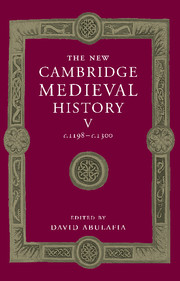Book contents
- Frontmatter
- Introduction
- Part I Common Themes
- Part II The Church in the Thirteenth Century
- 5 The papacy
- 6 The Albigensian Crusade and heresy
- 7 The Church and the laity
- 8 The Church and the Jews
- 9 The religious Orders
- 10 The universities and scholasticism
- Part III The Western Kingdoms
- Part IV Italy
- Part V The Mediterranean Frontiers
- Part VI The Northern and Eastern Frontiers
- Appendix Genealogical tables
- Primary sources and secondary works arranged by chapter
- Index
- Plate section
- Map 1 Europe in the thirteenth century
- Map 3 France, c. 1260
- Map 5 Germany and the western empire
- Map 6 Genoa, Venice and the Mediterranean
- Map 8 The Latin empire of Constantinople and its neighbours
- Map 10 Aragon and Anjouin the Mediterranean">
- References
7 - The Church and the laity
from Part II - The Church in the Thirteenth Century
Published online by Cambridge University Press: 28 March 2008
- Frontmatter
- Introduction
- Part I Common Themes
- Part II The Church in the Thirteenth Century
- 5 The papacy
- 6 The Albigensian Crusade and heresy
- 7 The Church and the laity
- 8 The Church and the Jews
- 9 The religious Orders
- 10 The universities and scholasticism
- Part III The Western Kingdoms
- Part IV Italy
- Part V The Mediterranean Frontiers
- Part VI The Northern and Eastern Frontiers
- Appendix Genealogical tables
- Primary sources and secondary works arranged by chapter
- Index
- Plate section
- Map 1 Europe in the thirteenth century
- Map 3 France, c. 1260
- Map 5 Germany and the western empire
- Map 6 Genoa, Venice and the Mediterranean
- Map 8 The Latin empire of Constantinople and its neighbours
- Map 10 Aragon and Anjouin the Mediterranean">
- References
Summary
BY the end of the twelfth century, apart from a few peripheral regions such as Finland or Lithuania, the Christianisation of western and northern Europe could be considered complete, if by this one understands that all the inhabitants, except for the Jews, who were very much in the minority, were baptised into the Catholic faith; there were, of course, Muslim populations in some areas, but these were almost without exception lands that had earlier been under Islamic rule. However, at the very moment when Christianity was attaining this territorial extent, the clerics were gradually becoming aware of the superficial nature of this conversion. Until then, the Church had always considered it sufficient for the ruling social classes to be converted, and then for the masses to follow suit; and the method of utilising the elite classes in this way had, on the whole, been successful since the end of the Roman empire. However, throughout the twelfth century, the situation changed: following the Investiture Dispute, the lay aristocracy in several countries became embroiled in conflicts with the ecclesiastical hierarchy and sometimes allowed itself to be influenced by heretical movements, as occurred in the 1170s in both Languedoc and Italy. Even in those areas where the lay aristocracy remained faithful to orthodoxy, it often stood in opposition to the clergy in matters of morality or in those affairs in which the clergy had a vested interest; and the clergy, for its part, could no longer count on unconditional devotion. On the other hand, the masses began to emerge from their passivity, in all aspects of life, aspiring to take control of their own fate, especially in the cities: witness the rapid expansion of the communal movement, which so often stood firm against the ecclesiastical authorities. Yet it was especially the success of the heresies in all the social milieux, from around 1170 onwards, that attracted the attention of the most vigilant clerics towards the lack of profound Christianisation. For if, in the space of a few decades, the population of entire regions had adhered to doctrines which were far removed from the doctrines of the Church, it meant that their faith was not very deeply rooted.
- Type
- Chapter
- Information
- The New Cambridge Medieval History , pp. 182 - 203Publisher: Cambridge University PressPrint publication year: 1999
References
- 1
- Cited by



